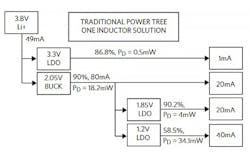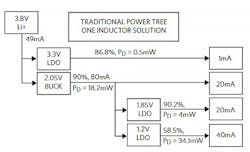Leverage SIMO Switching Regulators in Hearables and Wearables (.PDF Download)
Let’s be honest—for most engineers, the characteristics of the various power-regulator topologies are of only moderate interest at most. That makes some sense, since the subtleties of SEPIC (single-ended primary inductance converter), CV/CC (constant voltage/constant current), discontinuous conduction, and continuous conduction (and many more) are not what generally concerns the regulator user.
Instead, the basic parameters are of interest, starting with the dc output-rail voltage, the available current, and the necessary efficiency. After those top-tier factors, one must consider issues such as footprint, cost, required passives or MOSFETs, noise, and regulation. “What regulator topology will get us there?” isn’t the issue for designers. Instead, it’s “are we there yet?,” so that the design team can focus on the rest of the circuitry and its software.
However, there are applications where the power-regulation subsystem is a major aspect of the design effort. For example, for fitness-related wearables and “hearables” (wireless earbuds), a large part of the user experience is mostly dictated by what the battery capacity and regulators can deliver. These devices are severely size-constrained, yet the need to operate for many hours from a single charge isn’t only desirable, but mandatory.
1. The power tree of a hearable (or wearable) device shows an array of dc rails, all regulated from a single battery of very limited capacity.
The power flow for a representative hearable device (Fig. 1) shows the rails as well as the efficiency and dissipation associated with each. The power-management function includes a battery charger, a buck converter, and an LDO to power the sensors, while a second IC (a dual LDO) powers the microcontroller, Bluetooth function, and audio.
There’s an interesting characteristic in the normal, day-to-day operation of wearables and hearables: They operate at a low-to-moderate active-duty cycles, but are also often in standby mode. The device may be active for 4, 8, 12, or more hours between recharging periods, in principle, but for much of this time their actual mode is non-active. Therefore, standby current is a critical parameter for lengthy battery life on a single charge.

